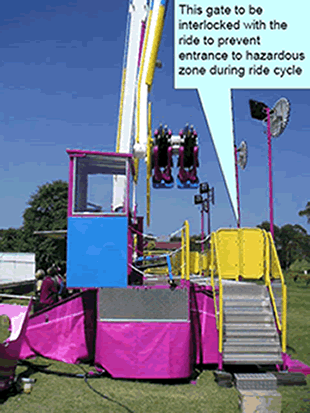Risk of being hit by moving parts of an aerial amusement ride
Issued: 4 March 2009
Purpose
To highlight and manage the risk of being hit by fast moving parts in the loading/unloading zone of certain aerial amusement rides, such as the 'Inverter' or a Frisbee style ride.
Background
An operator of an Inverter Ride in USA died on 19 October 2008 when he was hit by the counterweight of the ride.
The investigation found that the victim was taking measurements for future repairs and apparently thought the ride had finished its cycle. He moved into the path of the moving counterweight, which hit and killed him.
The carriage and counterweight of certain aerial amusement rides are physically not in the loading zone during the majority of the operation cycle. For a split second, these moving parts return and sweep across the passenger loading zone. It is critical that the operator (or any other person) is not in the hazardous zone during the operation cycle of these rides. Examples of such rides operating in Australia include the Claw, Hangover, Ranger, Ali Baba and No Limit. Photograph 1 shows an aerial ride and the gates into the hazardous zone.
This alert is not intended to cover situations where:
- maintenance gates are normally locked and the keys are only available to authorised persons;
- gates which are subject to documented lockout procedures, e.g. access gates leading to roller coaster track areas.

Photograph 1: View of an aerial ride showing the gates into the hazardous zone.
Recommended control measures
Owners of these types of rides must implement appropriate control measures such as:
1. Administrative controls
a. Safe operating procedures must be developed and enforced.
b. The barrier/gate is to be locked by the operator so that while the ride is moving, no person (attendant or patron) can access the platform through the gate after the starting of the ride.
2. Engineering controls
a. The gate shall not unlock until the ride is fully stopped. The reliability of the interlocking system to prevent unlocking shall be to an appropriate category in accordance with the risk assessment procedure set out in the Australian Standard AS4024.
b. Fencing around the platform should ensure that no one can easily access (e.g. climb into) the platform (e.g. fencing to be higher than 1600mm; see Appendix D, AS3533.2-1997, unless the loading zone is already on a raised platform). If this is not possible, an extra operator or an alarm system is needed to stop/warn patrons from climbing over the fence.
Legislative requirements
Sections 28, 32 and 36 of the Work Health and Safety Act 2011 lists health and safety obligations on anyone conducting a business or undertaking, whether as employer, self-employed person, designers, manufacturers, suppliers, installers and owners of plant and workers. Section 27A(2) details risk control principles.
For practical advice on how to manage exposure to risks when using plant download the:
- Managing the risks of plant in the workplace Code of Practice 2021 (PDF, 1.57 MB)
- How to manage work health and safety risks Code of Practice 2021 (PDF, 0.65 MB)
-
Amusement devices Code of Practice 2023 (PDF, 1 MB)